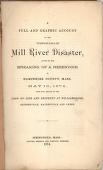|

"Terrible Horror" article from the Journal of Industry newspaper

Page from Josiah Allen diary regarding Mill River Disaster Flood

"A Full and Graphic Account of the Terrible Mill River Disaster, caused by the Breaking of a Reservoir in Hampshire County"
|
Summary and Objective
Students will understand that the Mill River flood of 1874 devastated a community yet brought out remarkable human qualities such as bravery, heroism, and resilience. Students will also understand that history can be translated into gripping non-fiction stories for children.
Teaching Plan
Step 1.
The teacher will read Letting Swift River Go, a vivid picture book about the flooding of four Massachusetts towns by the creators of the Quabbin Reservoir. She or he will discuss how author Jane Yolen turned a historic Massachusetts event into a storybook. The class will discuss who the narrator is and why she told her story as she did. How would a water official in Boston have told the story differently? How would the story be different if told from the perspective of an animal now living at the Quabbin, such as the eagles who have thrived there?
Step 2.
Over a few days, the teacher will read to the class all of "A Full and Graphic Account of the Terrible Mill River Disaster, caused by the Breaking of a Reservoir in Hampshire County." This is an "instant book" published within three weeks of the May 16, 1874, dam breaking in Williamsburg, Massachusetts. She or he may also read a short newspaper account called "Terrible Horror" and a diary excerpt from Josiah Allen that refers to the flood. The class will talk about the ways a diary entry differs from a newspaper account. Why, for example, does Josiah Allen write as much about his daily work farming as he does about the horrendous flood?
Step 3.
The class will discuss what parts of the event they should include in a children's book. Some examples may be George Cheney and Collins Graves' heroic rides to warn residents, descriptions of what the flood wave looked and sounded like, narrow escapes, how people were killed, and property damage.
Step 4.
With partners, children will choose a section of one of the primary sources (copied on separate pages by the teacher), read it, and write one to three sentences for the class picture book about that section.
Step 5.
After, the teacher and class will put the class's words into an order that makes sense, read the text aloud, and decide what else to add to make the book flow well.
Step 6.
The teacher will hand out copies of the draft. Each pair will revise the draft, focusing on sensory description, transitions, flow and accuracy.
Step 7.
The teacher and class will decide which revisions to incorporate, make the changes, illustrate the text, name the book, and present it to the school either at an assembly or by putting up the pages in the hallway.
|




